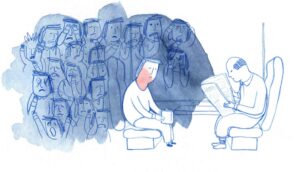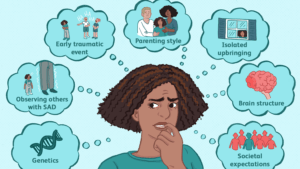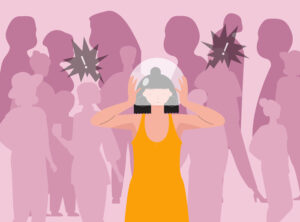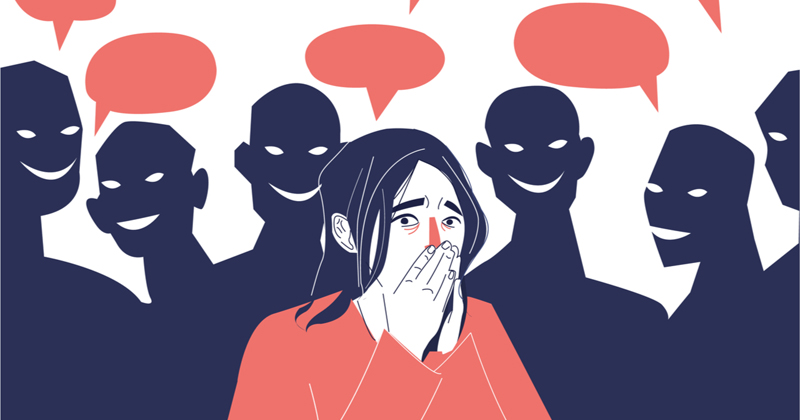Social anxiety disorder, also known as social phobia, is a mental health condition characterized by an excessive and irrational fear of social situations. People with this disorder often worry that they will say or do something that will embarrass or humiliate them in front of others. They may also fear that they will be judged or rejected by others. This can lead to a great deal of anxiety and avoidance in social situations. In this comprehensive guide, we will discuss all aspects of social anxiety disorder including its causes, symptoms, and treatment options. We hope that this information will help you get the relief you need and start living a happier life!
Contents
Defining Social Anxiety Disorder
Social anxiety disorder is a type of mental disorder that is characterized by an intense fear of social situations. This fear can be so debilitating that it interferes with a person’s ability to live a normal, happy life. People with social anxiety disorder often worry that they will say or do something that will embarrass or humiliate them in front of others. They may also fear that they will be judged or rejected by others. This can lead to a great deal of anxiety and avoidance in social situations.
One important to know that feeling nervous or fearful in social situations is a normal part of life. It is only when these feelings become so intense and persistent that they interfere with everyday functioning that they are considered to be a disorder. SAD affects approximately 15 million adults in the United States. It is one of the most common mental health conditions, yet it is often underdiagnosed and undertreated.
Social anxiety and its triggers may be small or big. For some people, the mere thought of attending a party or networking event can trigger an intense fear response. For others, it may only be triggered in certain situations such as public speaking or meeting new people. The key defining feature of social anxiety disorder is that the fear is excessive and unreasonable.
It is also important to understand that social anxiety disorder is not simply being shy or introverted. While shyness and social anxiety can share some similarities, they are not the same thing. Shyness is a normal personality trait while social anxiety disorder is a mental health condition. Meanwhile, introversion is a preference for solitary activities and minimal social interaction. It is not a disorder. Some people with the disorder are introverted, but many are not.
Signs And Symptoms

The symptoms of social anxiety disorder can vary from person to person. They may be mild in some people and more severe in others. Symptoms typically begin in childhood or adolescence and may persist into adulthood.
Some common symptoms of social anxiety disorder include:
- Worrying for days or weeks before an event
- Feeling intensely anxious or panicked in social situations
- Excessive self-consciousness
- Worrying about being judged or rejected by others
- Fear of embarrassing or humiliating oneself
- Anticipating social or performance situations with dread
- Fear of embarrassing or humiliating oneself
- Avoidance of social situations altogether
- Feeling like you are not good enough
- Difficulty making and maintaining eye contact
- Feeling like you are being watched or judged by others
- Sweating, trembling or feeling flushed when around others
- Nausea, stomachache, or diarrhea before or during social situations
- Difficulty talking to or interacting with others
- Feeling like you need to drink alcohol or use drugs to cope with social situations
Symptoms may vary in context and severity from person to person. For example, someone with social anxiety disorder may only feel anxious in certain situations, such as public speaking or meeting new people. They may be able to manage their fear in other social situations. Someone with severe social anxiety disorder, on the other hand, may feel anxious and uncomfortable in most, if not all, social situations. This can make even everyday activities extremely difficult.
It is also important to note that symptoms of social anxiety disorder can vary depending on the situation. For example, a person with social anxiety disorder may feel fine when they are around close friends but experience intense anxiety when they are around strangers.
Causes
The exact cause of social anxiety disorder is not known. However, it is thought to be a combination of genetic and environmental factors.
Environmental factors: Factors stemming from the environment around a person may trigger social anxiety disorder. For example, witnessing violence or other traumatic events can be a trigger. Having an overbearing or critical parent or guardian can also increase the risk of developing social anxiety disorder.
Genetic factors: Social anxiety disorder is thought to run in families. This suggests that there may be a genetic component to the condition. However, it is not clear how exactly it passes down from one generation to the next.
Brain structure and regulation: There is some evidence to suggest that social anxiety disorder may be caused by abnormalities in the way the brain processes and regulates emotions. For example, people with social anxiety disorder may have a hard time understanding and interpreting facial expressions. This can make it difficult to know how to respond appropriately in social situations.
Risk Factors

Several factors can increase the risk of developing social anxiety disorder. These include:
Life experiences: As mentioned above, witnessing violence or other traumatic events can be a trigger for social anxiety disorder. These can also include experiences such as having a bad presentation, falling, or tripping.
Culture: Social anxiety disorder is more common in cultures that place a high value on fitting in and being accepted by others. This may be due to the increased pressure to conform in these cultures.
Having another mental health condition: Those with other mental health conditions may be more likely to develop social anxiety disorder. Some examples include depression, substance abuse disorder, and attention-deficit/hyperactivity disorder (ADHD).
Experiencing trauma or abuse: People who have experienced trauma or abuse are at an increased risk of developing social anxiety disorder. Some examples of traumatic instances causing anxiety are sexual abuse, bullying, and the death of a loved one.
Being bullied or ridiculed: People who have been bullied or ridiculed are at an increased risk of developing social anxiety disorder. This happens because the experience can cause a person to feel shame, embarrassment, and isolation.
Having low self-esteem: People who have low self-esteem are at an increased risk of developing social anxiety disorder. This is so because they are more likely to believe that others are judging them.
Having perfectionistic tendencies: People who are perfectionists may be at an increased risk of developing social anxiety disorder. This is because they may feel that they have to meet unrealistic standards to receive acceptance and value in the society.
Effects On Daily Life
Social anxiety disorder has a major influence on a person’s quality of life.
- The fear and anxiety can make a person feel emotionally weak. This can present itself in the forms of depression, people pleasing, anger, frustration, guilt, embarrassment and low self-esteem. These negative emotions can make it hard to maintain healthy personal relationships and be successful in school or at work.

- In some cases, social anxiety disorder can lead to substance abuse as people try to self-medicate their anxiety with alcohol or drugs.
- It can also lead to agoraphobia, which is a fear of being in public places or situations where escape may be difficult. This can cause a person to avoid going outside altogether.
- It can make everyday activities and tasks extremely difficult to do. For example, going to work or school, grocery shopping, or even just leaving the house may be very anxiety-provoking for someone with social anxiety disorder.
- Intense fear is the most common symptom of social anxiety disorder. This fear can be so severe that it interferes with a person’s ability to live a normal, happy life.
- It also puts a strain on relationships. This happens when the fear of social situations leads a person to avoid them altogether. This can make it difficult to maintain friendships and develop new relationships.
- People with social anxiety disorder often worry that they will say or do something that will embarrass or humiliate them in front of others. They may also fear that they will face judgement or rejection by others.
- Social anxiety disorder may also make people experience physical symptoms such as sweating, trembling, racing heart, difficulty breathing, and nausea. These symptoms can be so intense that they interfere with a person’s ability to function normally in social situations.
Living with social anxiety disorder can be very isolating and lonely. The constant worry and fear can take over a person’s life. It is important to seek help if you think you or someone you know may have social anxiety disorder.
Diagnosis
If you think you may have social anxiety disorder, it is important to see a mental health professional for diagnosis and treatment. A mental health professional can rule out other conditions that may be causing your symptoms and make a treatment plan. There are several different types of professionals who can diagnose and treat social anxiety disorder. These include:
Psychiatrists: Psychiatrists are medical doctors who specialize in diagnosing and treating mental health conditions.
Psychologists: Psychologists have their education and training in assessing and treating mental health conditions. They do not prescribe medication but may provide talk therapy or other types of therapy, such as cognitive-behavioral therapy.
Licensed clinical social workers: Licensed clinical social workers are trained in assessing and treating mental health conditions. They also provide talk therapy and may offer other types of therapy, such as cognitive-behavioral therapy.
They may use different methods to assess whether you have an anxiety related disorder. These may include:
- Asking questions about your symptoms and when they started, and what is their frequency and intensity
- Asking about your family history of mental health conditions
- Conducting a physical exam to rule out other conditions that may be causing your symptoms
Most diagnostic criteria for anxiety disorders is referenced from the Diagnostic and Statistical Manual of Mental Disorders, Fifth Edition, commonly known as the DSM-5, as it is the most widely accepted and credible source for assessing and diagnosing mental illnesses.
If you have a diagnosis with social anxiety disorder, the mental health professional will work with you to develop a treatment plan. This will likely involve talk therapy, medication, or both.
Treatment Options

Although there is no known cure for SAD, there are multiple ways and interventions through which one can manage and also reduce the symptoms and lead a fruitful and easier life. This can happen through the help of a mental health professional, adoption and practice of self-coping strategies, or a combination of both.
Professional Help
There are several effective treatments for social anxiety disorder. These include:
Cognitive-behavioral therapy: Cognitive-behavioral therapy is a type of talk therapy that can help people with anxiety disorders by teaching them how to change their thoughts and behaviors. CBT uses multiple strategies such as
Psychotherapy: Psychotherapy is a type of talk therapy that can help people with social anxiety disorder by teaching them how to manage their emotions and cope with their symptoms.
Exposure therapy: Exposure therapy is a type of cognitive-behavioral therapy that involves gradually exposing a person to the situations they fear. This can help them to learn how to cope with their fears and eventually overcome them. Exposure therapy involves gradual exposure and desensitization toward the person’s triggers.
Medicines: The most common type of medication used to treat anxiety is a type of antidepressant called a selective serotonin reuptake inhibitor (SSRI). SSRIs work by increasing levels of serotonin in the brain, which can help to improve mood and reduce anxiety. Examples of SSRIs include fluoxetine (Prozac), sertraline (Zoloft), and paroxetine (Paxil). Other types of medication that treat anxiety disorders include beta-blockers and anti-anxiety medications. Beta-blockers can help to reduce the physical symptoms of anxiety. Anti-anxiety medications can help to reduce feelings of anxiety and fear. Examples of anti-anxiety medications include lorazepam (Ativan) and diazepam (Valium).
NOTE: it is important to stay in touch with your doctor to monitor and assess the side effects, benefits and efficacy of the medication. This is important to do as different people react differently to medication and it may sometimes worsen the conditions.
It is important to work with a mental health professional to find the treatment that is right for you. Not all treatments work for everyone, and some people may need to try different treatments before they find one that helps.
Self-Help Strategies
In addition to professional help, there are several things you can do on your own to help manage their anxiety. Some self-help strategies include:
Identifying your triggers: Triggers are things that make your symptoms worse. Identifying your triggers can help you to avoid them or even prepare for them in an event when they do occur.
Building up your confidence: One way to reduce social anxiety is to build up your confidence. This can be build up by practicing assertiveness, setting goals, and complimenting yourself.
Challenging negative thoughts: Negative thinking is a common symptom of the disorder. Challenging these negative thoughts can further help you to reduce your anxiety and improve your mood.
Practicing relaxation techniques: Relaxation techniques can help you to manage your anxiety by reducing the physical symptoms of anxiety. Some relaxation techniques include deep breathing, progressive muscle relaxation, and visualization.
Making lifestyle changes: There are some lifestyle changes that can help to reduce the symptoms of social anxiety disorder. These include activities such as getting regular exercise, eating a healthy diet, getting enough sleep, and reducing stress.
Support groups: There are many support groups available for people with anxiety disorders. These groups provide a safe place to share your experiences and feelings with others who understand what you are going through.
Conclusion
In conclusion of the above, social anxiety disorder is a type of mental disorder that can cause significant distress in social situations. It is important to seek professional help if you think you may have this disorder. There are many treatments available that can help to reduce the symptoms of this condition. In addition, there are several things you can do on your own to help manage and reduce your symptoms. These self-help strategies can be helpful along with professional treatment or on their own.
For more information, please contact MantraCare. Anxiety is a common mental health condition characterized by persistent feelings of worry, fear, and apprehension. If you have any queries regarding Online Anxiety Counseling experienced therapists at MantraCare can help: Book a trial Anxiety therapy session


